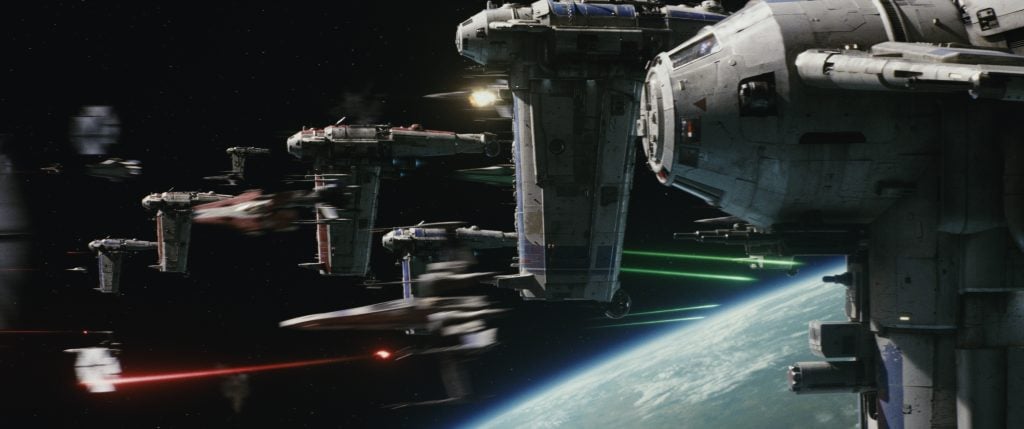After all the discussion about the themes and characters of ‘The Last Jedi’, most of us have finally reached the acceptance stage of fan grief. We agree to disagree either because we acknowledge that opinions are subjective or because we’ve been beaten into submission and just can’t argue anymore. I may not be able to rightly say that that guy on the Internet is wrong… unless, of course, it’s about science.
Science is the only thing objective about science fiction. It is something media must represent well enough for audiences to suspend disbelief when it comes to aliens and “laser swords.” ‘The Last Jedi’ meets that threshold for enough viewers, but perhaps just barely. The latest Star Wars offering may get a pass because the public’s science education is not what it could be. Let’s look at what ‘The Last Jedi’ got wrong about its primary setting: space.
Spoilers for ‘The Last Jedi’ follow, but honestly, if you haven’t seen it yet, you’re not reading this anyway.
The movie opens with the remaining ships of the Resistance meeting a far more powerful First Order fleet. From here there are a couple things we should accept. As Star Wars fans, we should accept that the bad guy’s ships are designed so horribly, a single X-Wing taking out a Star Destroyer’s defenses is par for the course. As sci-fi fans, we should accept that amazing tech can exist and long as its effect is consistent with real physics. The Resistance deploys heavy bombers over the Star Destroyer with the expectation that bombs will fall on their targets and fall they did. Some say this is in clear violation of physics, but, take it from someone who is about to point out violations of physics, they are mistaken. The B/SF-17 Heavy Bombers, along with every Star Wars ship I can think of, has artificial gravity. You can tell by the people walking inside. The bombs fall according to the artificial gravity of the ship. Their momentum continues in the frictionless environment of space until they hit the other ship. No problemo.
The Resistance ships, knowing it’s impossible to defend against the remaining First Order fleet, flee to hyperspace. The First Order tracks them and the chase is on again. For story reasons, this chase needs to continue for Finn and Rose to travel to a space casino, get captured, escape, travel back to the First Order ship, and get captured again. They say how long this takes in dialogue, but who knows what units of time they are using. It’s not like that have earth days. We can assume it takes a long time.
Director Rian Johnson has to rationalize why the best ships of the extremely well funded Last Order can’t catch a few rebel vessels that are nearly out of gas, I get it. The explaination he came up with, told to General Hux on screen, is that the Resistance ships are lighter. Lighter! In space, each ship — from the gigantic Snoke-mobile to the Raddus’ lightboats — are weightless. There is no “lighter.”
Let’s break it down further. A Resistance ship is traveling through space. Without using fuel, it would have a constant speed. We know they are using fuel so we know that the ship does not have a constant speed. It is accelerating. The same can be said for the First Order ships. The Star Destroyer has a larger engine, a larger fuel reserve, and probably better tech. We should expect the First Order to overtake the rebels very quickly.
Half a movie later, the First Order finally gets the Resistance flagship, the Raddus, where they want it and opens fire on its escaping lifeboats. Vice Admiral Holdo puts a stop to it in a beautifully shot scene that took me completely out of the remainder of the film. She warps into Snoke’s ship, splitting it in two.
Can one criticize the science here considering we have no idea how hyperdrives work? Not really, but let’s try. Best guess is that hyperdrives work in one of two ways. First, it could accelerate the vessel to light speed. Modern science suggests that’s impossible, but, if it could happen, it would cause considerably more damage than shown. The Raddus’ momentum and energy would be infinite, particles of Star Destroyer would fuse with particles of Stormtroopers with gamma rays galore. Everyone in a ship, any ship, would die. Option two involves the space ahead of the Raddus becoming compressed which would tunnel a wormhole through the First Order ships… or something. As Doc Brown would say, I don’t think 4th dimensionally enough to speculate.
What took me out of the movie was the implications of the “Holdo Maneuver.” Say the Raddus is a fifth the mass of Snoke’s ship, the Supremacy. Almost every space-faring vessel in the Star Wars universe has a warp drive. The implication of this scene is that any very small ship could sacrifice itself for the destruction of any very large ship. It begs the question: why not warp a single heavy bomber into the star destroyer at the movie’s opening and leave the rest of the ships docked? It throws the entire history of Star Wars into question. Just warp a series of X-Wings into the Death Star weapon dish and be done with it. It’s possible that no one knew the effect of such a tactic, but now they do. Title of the next movie should be ‘Star Wars: The Hyperdrive Menace.”
The inclusion of fantastical elements like the Force should not exempt the rest of the universe from consistent physical laws.
What did you think about the science of ‘The Last Jedi’?

